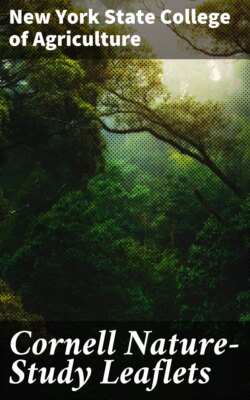Читать книгу Cornell Nature-Study Leaflets - New York State College of Agriculture - Страница 19
На сайте Литреса книга снята с продажи.
Fourth Grade.
ОглавлениеAfter having studied Insect Homes, the pupils will be ready to take up the broader subject, How Insects Live. The work of this year may be given on this subject.
In order to study the life-histories of insects, the pupils should know some things about insect anatomy. If the work as indicated in the previous grades has been followed, the pupils know the number of legs, wings, and compound eyes most insects have, without ever having killed a specimen or having received a special lesson in insect anatomy. Now teach the children how insects breathe and how they eat. Show the spiracles on the body of any caterpillar which is not hairy; they may be seen on the abdomen of a grasshopper or of a butterfly that has not too many large scales to cover them.
After they have seen these spiracles or breathing pores, give a lesson, illustrated by chart or blackboard, showing that these holes lead to the breathing tubes of the body. Manual for the Study of Insects, pp. 73-75.
To show how insects eat, allow the pupils to watch the following insects in the breeding cages while feeding: a grasshopper; a leaf beetle (potato beetle is a good example); any caterpillar; an ant; and a wasp. Show that all these have mouth parts made for biting. Let the pupils see an aphid sucking the juice of a plant; this may be done by bringing in a twig infested by aphids. Let the pupils see the water bugs in the aquarium eat. Insect Life, pp. 123-131, and pp. 137-140. Let them watch a fly, a honey bee, and, if possible, a butterfly or moth, eat. All these have mouth parts made for sucking. All this work should be original investigation on the part of the pupils.
After the pupils find out how insects breathe and eat, let them see how each insect lives a life adapted to its own peculiar needs. Try to feed some cabbage worms on clover or grass. Then try turnip or mustard leaves, and watch the result. Change the potato beetle larvæ to some other plant, and watch the result.
Let the pupils first find out how the insects breathe in the water. Each insect in the aquarium tells a different story as to its way of getting air. The teacher will find all these stories indicated in the chapters in Insect Life devoted to pond and brook insects.
Call especial attention to protective coloring of insects. Show that when an insect resembles its surroundings in color it is thereby enabled to escape its enemies; or, if need be, is enabled to creep upon its prey unobserved.
Note the color of the grasshopper in the road; color of meadow grasshopper; color of the caterpillars of the cabbage butterfly (green and hard to find). Notice the shape and color of walking sticks; color of the katydids. Note the bright color of the larvæ of potato beetle. Why? (They are distasteful to birds, and their colors advertise the fact.) Study the Monarch butterfly and the Viceroy. Everyday Butterflies, p. 95 and p. 297; Ways of the Six-Footed, p. 39. Bring out strongly in all this work that the insect in order to live must have its special food plant and must escape notice of its enemies. This is the proper place to begin the study of the valuable work done by birds in destroying insects.
In addition to this general work, study especially the wasps.
Solitary Wasps: Mud daubers. Bring in their nests and examine them. Ways of the Six-Footed, p. 96. How are the nests provisioned, and for what purpose were they made? Find, if possible, nests of other solitary wasps. Insect Life, p. 218, p. 262, p. 264.
Social Wasps: Bring in a deserted nest of yellow-jackets. Of what is it made? How? What for? Do the wasps store honey? Do they live as a colony during the winter? All these questions may be answered by a pupil who knows of a yellow-jackets' nest in the fall and watches it during the winter. For the teacher there are discussions of these insects in Manual for Study of Insects, pp. 660-664. Wasps and their Ways.
Continue the butterfly collection and the butterfly calendar.
Spring work.—In the spring, begin a collection of moths for the schoolroom. Insect Life, p. 50. Caterpillars and Moths.
In the spring, notice when the first house-flies appear. What happens to the house-fly in winter? (Send for Circular No. 35, second series, Div. of Entomology of Department of Agriculture, Washington, D. C., for the life-history of the house-fly.) Explain that one female destroyed early in the season means thousands fewer late in the season.
Encourage the children to bring to the schoolroom all sorts of flies and compare them with the house-fly. The object of this is to teach something of the wonderful variety of forms among small and inconspicuous insects. Make a collection of flies for the schoolroom. For description of flies, see Insect Life, pp. 83-84.
A good plan for the spring work is to keep the pupils interested in the first appearance, after the vicissitudes of winter, of each insect which it is possible for them to find. Note that insects do not appear before their food plants appear.
Summary of objects and methods.—The questions to be answered during the whole year's work are: How do the Insects live,—on what do they feed? How do they escape their enemies? What happens to them in winter? How are the new broods started in the spring? The work is chiefly observation, but occasional lessons may be given and stories may be told to keep the interest in the work from flagging.
